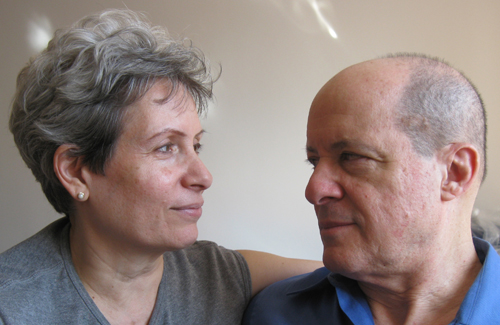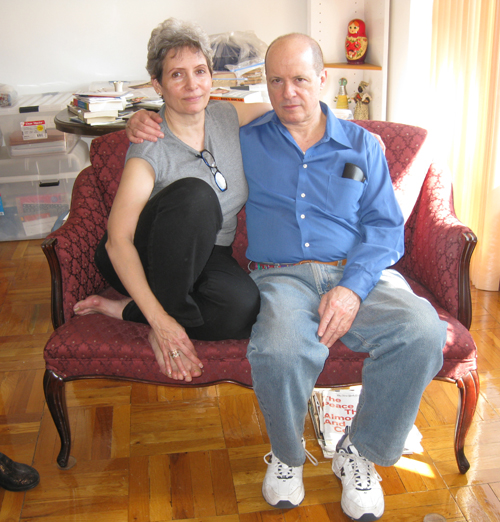Modest.
Gil Fagiani, master of singular syllables, gets right to the point.
Maria Lisella isn’t so stingy with her speech. She lets her sentences run in circles like water whooshing down a drain as she searches for the single word that best defines her.
Adaptable. That’s it, she finally says.
Gil and Maria, husband and wife, are poets. As the word “modest” suggests, Gil is the quieter one. He lets his brown eyes, intense enough to bore a hole through a steel beam, do a lot of his speaking.

Photo by Nancy A. Ruhling
Word wizards Maria and Gil.
Maria is as vivacious as her vocabulary; she’s adaptable. She’s equally happy sitting at home writing or charming the formal airs off VIPs.
“When I met Gil, I thought English was his second language as he had such a studied way of speaking,” she says. “The joke was that yes, it is true, silence is his first language, something I have learned from.”
Well, sort of.
Maria, a former trade-magazine editor, is a freelancer who pens travel pieces; Gil, a social worker and addiction specialist, directs a residential support program for recovering alcoholics and drug addicts in downtown Brooklyn. Together, they run the long-running Italian American Writers’ Association readings held every month at The Cornelia St. Café in Greenwich Village.
Five. Eleven.

Photo by Nancy A. Ruhling
Gil discovered the power of the pen later than Maria.
Those are the next two words that move the story of Gil and Maria along.
At five, Gil’s world turned upside down when his family moved from the Bronx — “my garden of Eden” — to Stamford, Connecticut, “the country.”
At 11, Maria was forced to trade her multi-racial neighborhood of South Jamaica, Queens, for Bellerose, where everything was seen in black and white.
“It was my first experience with racism,” she says. “We were Italian-Americans; we got dark tans in the summer, and people called us names.”
Gil, who wasn’t a good student, changed his destiny by enrolling in a Pennsylvania military academy, where he toed the line. OK, that didn’t last long. Once he tuned into the anti-war movement — it was the late 1960s — he helped found White Lightning, a radical group.

Photo by Nancy A. Ruhling
Maria specializes in travel writing.
“Our position was that peaceful change wasn’t possible in America,” he says. “That’s what I believed, but I never set off any bombs.”
During a summer internship with the East Harlem Tenants Council, he discovered the drug culture and immediately immersed himself in what he calls his “heroin career.”
“I was addicted for two years,” he says. “After that, I took up drinking and became an alcoholic. That lasted about two decades.”
While Gil was finding — and losing — himself, Maria, a good Catholic girl, set her heart on being a dancer, only to get it broken.
“Nobody would let me take tap because we lived in an apartment, and we couldn’t make that much noise,” she says. “So I studied ballet. I tried out for the American Ballet Theatre at 16, but I didn’t make it.”
She later joined Charles Weidman’s modern dance troupe and added poetry and local politics to her repertoire.

Photo by Nancy A. Ruhling
Maria’s latest poetry books.
Going to college and getting out in the work world further raised her political consciousness, and she embraced feminism, going so far as to sue the labor union she worked for. Hers was one of the country’s first successful sexual harassment suits.
“I was supposed to marry someone my parents had chosen, and I was dating him,” she says. “But I refused to go through with it.”
Gil, by this time, had taken a wife and was working as an attendant at a Bronx psychiatric hospital. Eventually, he had two sons.
“My former wife is schizophrenic, but I didn’t know it at the time,” he says. “So are the children. One is hospitalized; the other lives with my ex-wife.”
Gil and Maria connected when Gil recruited Maria’s boyfriend to White Lightning. The boyfriend became history, and so did Gil and Maria.

Photo by Nancy A. Ruhling
Maria and Gil critique each other’s work.
“We started going out after a demonstration,” she says. “On our first date, we went to the Italian film The Night of the Shooting Stars.”
Although Gil, whose great-uncle was the noted 20th-Century Abruzzo poet Cesare Fagiani, didn’t take up writing as early as Maria, he says he’s “always had an attraction for language.”
He is drawn to what he calls “the intensity of the concentrated power of poetry,” and his books focus on his life experiences.
For Maria, “words are comforting. They remind me of being in my childhood, which I liked.”
They put rhyme with reason in their word works; A Blanquito in El Barrio is Gil’s autobiographical poem to H — heroin. And Maria chronicles some of her worldwide-flung adventures in Amore on Hope St. and Two Naked Feet.
Gil and Maria don’t complete each other’s thoughts or even their sentences, but they do look over each other’s work. Pieces awaiting honest-eye critiques are placed in their “scambio” or exchange folder.

Photo by Nancy A. Ruhling
Gil is the more silent partner.
“We reinforce our individual muses,” Gil says.
Adds Maria: “We’ve helped each other grow as writers, and we’ve helped each other re-connect with our Italian roots.”
Who has the last word?
Gil, once again, goes first. “Dynamic,” he says without hesitation. That’s his word for Maria.
Maria, picking one for Gil, comes around — finally — to “heroic.”

Photo by Nancy A. Ruhling
Maria and Gil infuse their poetry with real-life experiences.
“He’s heroic because he overcame his addictions, and he’s self-taught in many ways,” she says. “He never stops learning, and that’s what makes a partner interesting.”
Heroic? Gil denies it.
“Maria’s the fearless one,” he says. “She’s always walking up to strangers of status and asking them questions. I could never do that.”
Nancy A. Ruhling may be reached at Nruhling@gmail.com.
Copyright 2011 by Nancy A. Ruhling
